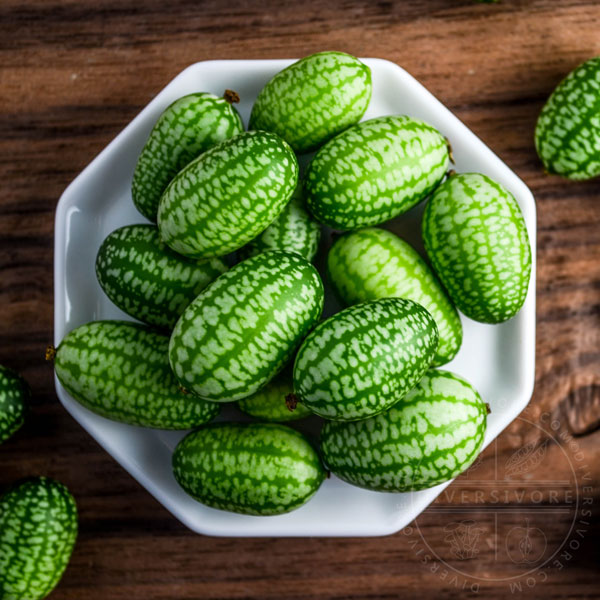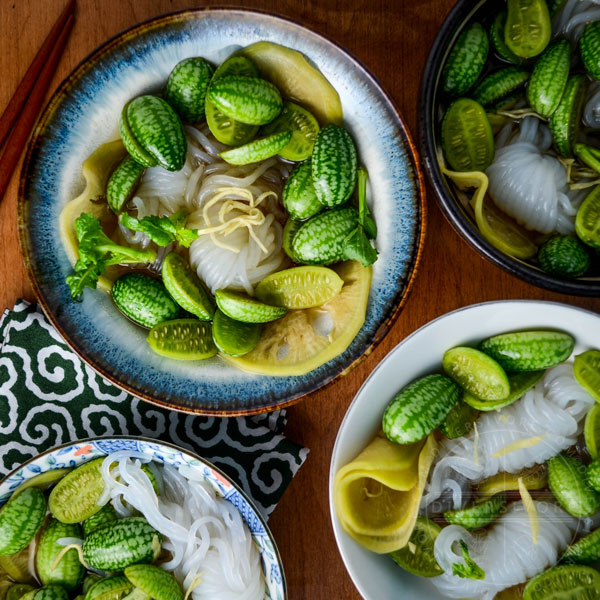How to Find, Choose, & Use
Cucamelons

Share this Guide
The Basics
What Are They?
Small edible fruits of the cucamelon vine, a member of the melon/gourd family Cucurbitaceae.
Seasonality
Most commonly available in mid/late SUMMER
Flavour Profile
Mildly green and cucumber-like, with a somewhat sour, lemony character.
Other Names
English: Mouse melon, Mexican sour gherkin, Mexican sour cucumber, Mexican miniature watermelon, pepquino
Spanish: Sandita, pepinillo agrio, melón riata
Cucamelon FAQs
How do you eat cucamelons?
Simply wash them and eat them whole. You can slice them too if you like. As with cucumbers and their relatives, they can be cooked, but they're generally used raw.
Are cucamelons a GMO?
Cucamelons are not genetically modified, or genetically engineered. They are native to Central America, where they have been grown since before European contact.
What do cucamelons taste like?
Cucamelons taste quite a bit like cucumbers, but with a slightly sour, lemony character. The edible skin is crisp and very slightly bitter.
How-To
Find
Though cucamelons have grown in popularity in recent years, they remain uncommon at conventional grocery stores. Farmers markets are going to be your best bet. They're also very popular with home vegetable gardeners.
Choose
Choose firm, unblemished cucamelons that are (generally) about the size of a medium table grape (no more than 1 inch/2.5 cm). Avoid soft or yellowed fruits.
Prep
Difficulty: Easy - Simply wash and serve. Cucemelons can be left whole or sliced, but this is primarily a cosmetic decision.
Use
Generally eaten raw, but also pickled or used in salsas. Cucamelons can also be cooked, but tend to be best when cooked quickly or lightly (e.g. in a stir-fry).
Store
Short Term: Keep in a paper or breathable plastic bag in your fridge's crisper drawer for 5-7 days.
Long Term: Fresh cucamelons can't be stored for a long period of time, but they will keep for many months when pickled.
Culinary Info
Flavour Profile
Mild/Green/Sour - Cucamelons have a mild, green cucumber-like flavour, with a somewhat sour, lemony edge. As with cucumbers, older fruits can be somewhat bitter.
Substitutions
From a flavour perspective, cucumber is a good substitute - especially with a bit of added lemon juice or vinegar to replicate the acidity. Small, firm cucumber varieties with a crisp skin (e.g. Lebanese/Japanese cucumbers) tend to substitute the best in terms of texture. That being said, cucamelons are fairly unique in terms of size, appearance, and texture.
Cuisines
Cucamelons have long been used in Mexican and Central American cuisine, but their mild, cucumber-like flavour and aesthetic appeal lends them to virtually any cuisine from around the globe.
Flavour Pairings
Cucamelons are quite neutral, and pair well with the same sorts of foods that you would find paired with cucumber. Chilies, tomatoes, garlic, citrus, vinegar, herbs, and salty cheeses are all excellent partners.
Varieties
Cucamelons are an open-pollinated heirloom food, largely unchanged by domestication. As best as I can tell, there are no varieties of note. There are, however, related species (see note below).
More Info
Nutrition
NOTE: I have been unable to locate verified nutritional information for cucamelons. The following is instead the nutritional information for a 100 g (3.5 oz) serving of Lebanese cucumbers. While not perfect, the data should be very similar.
Low in calories and fat; not a significant source of vitamins or nutrients.Nutrition FactsLebanese Cucumber - 100 grams (3.5 oz)Amount Per ServingCalories 15 Calories from Fat 9% Daily Value*Fat 1g2%Saturated Fat 1g6%Sodium 2mg0%Potassium 147mg4%Carbohydrates 4g1%Fiber 1g4%Sugar 2g2%Protein 1g2%Vitamin A 105IU2%Vitamin C 3mg4%Calcium 16mg2%Iron 1mg6%* Percent Daily Values are based on a 2000 calorie diet.Top-To-Tail
Cucamelons themselves are eaten in their entirety, including the seeds and the thin skins. There is little information about the edibility of the leaves, stems or roots, and they probably should not be consumed unless concrete scientific studies demonstrate their safety.
GMO Status
There are no GM or gene-edited cucamelons in the food supply or in experimental settings.
Health & Science
- Cucamelons haven't been the subject of much scientific investigation to date.
- There are a number of small cucumber-like species related to the cucamelon, but information about edibility is limited or nonexistent. This is further complicated by the evolving and often-unclear relationships between these various species. As a general rule, only cultivated true cucamelons should be considered as a reliable food source.Organic vs. Conventional
Commercial cucamelon production exists only at a small scale, so certified organic products are not likely to be found. That being said, their popularity with home gardeners and small farms, coupled with the plant's resistance to disease and hardy growth, means that cucamelons are often grown with organic or minimal-input methods.
Share this Guide


